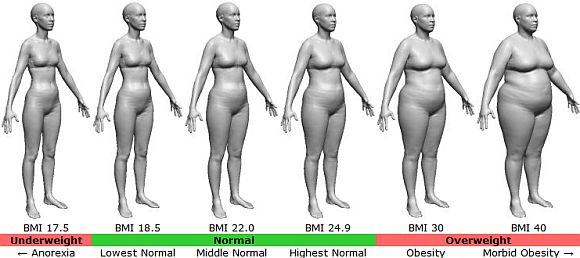As people reach middle age it becomes more frequent to forget names, certain words, or where they left their keys. These midlife experiences strike people later or earlier than others. While it is known that genetics play a role in this, the idea of physical activity and it influence has always been unclear until recently. Dr. David R. Jacobs has just now concluded after a study that the ability to think well during your middle age depends on a large degree of your lifestyle as a young adult. "It looks like the roots of cognitive decline go back decades," said Dr. Jacobs. With that in mind think to yourself: how active are you? Are you living a physically active lifestyle or significantly sedentary? To help see how you compare to others your age here are some ways in which to compare your physical physique with others your age.
Body Mass Index
Body Mass Index (BMI) is calculated from a person's weight and height. BMI is a somewhat reliable way to calculate an accurate body fat percentage. It is not as accurate as other methods, but this gives you an idea as to where you fall under. Your BMI is calculated using the following formula:
weight(kg) / (height(m) x height(m))
When you calculate your BMI, you can compare it to the chart according to your gender to see where you lie with the rest of the general population.


BMI
| Weight Status |
|---|---|
| Below 18.5 | Underweight |
| 18.5 – 24.9 | Normal |
| 25.0 – 29.9 | Overweight |
| 30.0 and Above | Obese |
| Measurement Units |
Formula and Calculation
|
|---|---|
| Kilograms and meters (or centimeters) | Formula: weight (kg) / [height (m)]2
With the metric system, the formula for BMI is weight in kilograms divided by height in meters squared. Since height is commonly measured in centimeters, divide height in centimeters by 100 to obtain height in meters.
Example: Weight = 68 kg, Height = 165 cm (1.65 m)
Calculation: 68 ÷ (1.65)2 = 24.98 |
| Pounds and inches | Formula: weight (lb) / [height (in)]2 x 703
Calculate BMI by dividing weight in pounds (lbs) by height in inches (in) squared and multiplying by a conversion factor of 703.
Example: Weight = 150 lbs, Height = 5'5" (65")
Calculation: [150 ÷ (65)2] x 703 = 24.96 |
How does your physical ability compare?
The Presidents Test consists of varied physical challenges that you can complete. By comparing your time or amount completed you can see how you compare to the general population.
Follow the link below with the following information to see what percentile you fall under.
http://well.blogs.nytimes.com/2014/05/07/a-fit-body-at-25-a-fit-brain-at-50/?module=BlogPost-Title&version=Blog%20Main&contentCollection=Phys%20Ed&action=Click&pgtype=Blogs®ion=Body
http://www.cdc.gov/healthyweight/assessing/bmi/adult_bmi/
https://www.presidentschallenge.org/challenge/physical/benchmarks.shtml
Google Images









